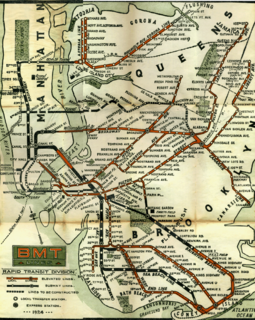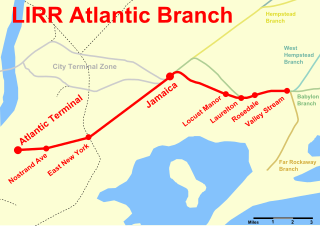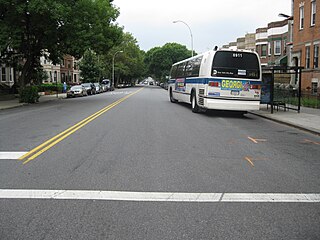This article needs additional citations for verification .(October 2016) (Learn how and when to remove this template message) |
The Hudson Avenue Line was a horse car street railway line in Brooklyn, New York City, United States, running mostly along Hudson Avenue in Vinegar Hill, near Downtown Brooklyn. It was short-lived, operating only from 1867 to 1871, but its trackage rights over the Brooklyn City Rail Road allowed the Atlantic Avenue Railroad to operate South Ferry-Prospect Park cars for many years.

Brooklyn is the most populous borough of New York City, with an estimated 2,648,771 residents in 2017. Named after the Dutch village of Breukelen, it borders the borough of Queens at the western end of Long Island. Brooklyn has several bridge and tunnel connections to the borough of Manhattan across the East River, and the Verrazzano-Narrows Bridge connects Staten Island. Since 1896, Brooklyn has been coterminous with Kings County, the most populous county in the U.S. state of New York and the second-most densely populated county in the United States, after New York County.

The City of New York, usually called either New York City (NYC) or simply New York (NY), is the most populous city in the United States and in the U.S. state of New York. With an estimated 2017 population of 8,622,698 distributed over a land area of about 302.6 square miles (784 km2), New York is also the most densely populated major city in the United States. Located at the southern tip of the state of New York, the city is the center of the New York metropolitan area, the largest metropolitan area in the world by urban landmass and one of the world's most populous megacities, with an estimated 20,320,876 people in its 2017 Metropolitan Statistical Area and 23,876,155 residents in its Combined Statistical Area. A global power city, New York City has been described as the cultural, financial, and media capital of the world, and exerts a significant impact upon commerce, entertainment, research, technology, education, politics, tourism, art, fashion, and sports. The city's fast pace has inspired the term New York minute. Home to the headquarters of the United Nations, New York is an important center for international diplomacy.

The United States of America (USA), commonly known as the United States or America, is a country composed of 50 states, a federal district, five major self-governing territories, and various possessions. At 3.8 million square miles, the United States is the world's third or fourth largest country by total area and is slightly smaller than the entire continent of Europe's 3.9 million square miles. With a population of over 327 million people, the U.S. is the third most populous country. The capital is Washington, D.C., and the largest city by population is New York City. Forty-eight states and the capital's federal district are contiguous in North America between Canada and Mexico. The State of Alaska is in the northwest corner of North America, bordered by Canada to the east and across the Bering Strait from Russia to the west. The State of Hawaii is an archipelago in the mid-Pacific Ocean. The U.S. territories are scattered about the Pacific Ocean and the Caribbean Sea, stretching across nine official time zones. The extremely diverse geography, climate, and wildlife of the United States make it one of the world's 17 megadiverse countries.
The Hudson Avenue Railroad opened the line in late 1867, [1] from the Hudson Avenue Ferry to Gouverneur Slip in Manhattan south along Hudson Avenue and the Brooklyn City Rail Road's Flatbush Avenue Line trackage [2] on Flatbush Avenue to Ninth Avenue at Prospect Park. The ferry stopped running in early June 1868, and the company asked the Common Council to lay track in John Street and Bridge Street to the Bridge Street Ferry to James Slip in Manhattan. [3] Consent was given later that month, [4] and the new line was opened by August 18, 1868. [5] However, this did not draw enough traffic from the Bridge Street Ferry to turn a profit, and it shut down for the winter. [6] In mid-1869, the Brooklyn and Jamaica Railway (Atlantic Avenue Line) leased the Hudson Avenue Railroad, [2] [7] in part to use its Brooklyn City Rail Road trackage rights to reach Prospect Park from South Ferry; [8] cars to the Bridge Street Ferry began operating again in August. [9] The track was removed by the city in 1871 to build a sewer, and was never relaid. [10]

Manhattan, often referred to locally as the City, is the most densely populated of the five boroughs of New York City and its economic and administrative center, cultural identifier, and historical birthplace. The borough is coextensive with New York County, one of the original counties of the U.S. state of New York. The borough consists mostly of Manhattan Island, bounded by the Hudson, East, and Harlem rivers; several small adjacent islands; and Marble Hill, a small neighborhood now on the U.S. mainland, physically connected to the Bronx and separated from the rest of Manhattan by the Harlem River. Manhattan Island is divided into three informally bounded components, each aligned with the borough's long axis: Lower, Midtown, and Upper Manhattan.

Flatbush Avenue is a major avenue in the New York City Borough of Brooklyn. It runs from the Manhattan Bridge south-southeastward to Jamaica Bay, where it joins the Marine Parkway–Gil Hodges Memorial Bridge, which connects Brooklyn to the Rockaway Peninsula in Queens. The north end was extended from Fulton Street to the Manhattan Bridge as "Flatbush Avenue Extension".
The Bridge Street Ferry was a ferry route connecting Manhattan and Williamsburg, Brooklyn, New York City, United States, joining James Slip (Manhattan) and Bridge Street (Brooklyn) across the East River.








